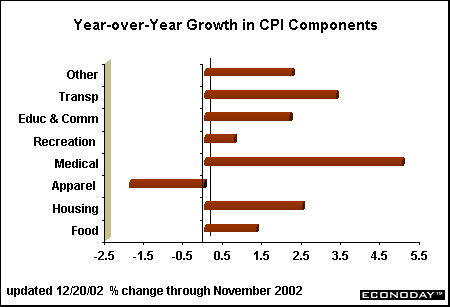
Housing starts holding strong
Housing starts rose 2.4 percent in November to a 1.7 million-unit rate, recovering only a portion of the 8.4 percent drop recorded in October. The Census Bureau, who compiles and releases the data, believes that 5-month averages of the series most accurately describe trends. The chart below shows a 5-month moving average of total housing starts and single family starts since 1998. Note that the 5-month period ending in November suggests that starts remain at healthy levels - nearly as strong as the highs reached in 1998 and 1999.

Housing strength trickles down to other areas of the economy. For instance, year-over-year sales at furniture and home furnishing stores have improved markedly in 2002 from the weakness registered in the previous year. The continued strength in housing starts suggests that furniture and home furnishing sales may grow further in coming months.

Production trends still soggy...but light at the end of the tunnel?
The index of industrial production edged up 0.1 percent in November after declining 0.6 percent in October. Production of consumer goods increased nicely, but business equipment declined yet again. Among major market groups, it is the only sector still showing declines from year-ago levels. Among major industry groups, manufacturing production edged up 0.1 percent in November and is now 1.4 above last November's levels. Utilities were unchanged in November but 8.4 percent above a year ago. Mining managed a 1.3 percent jump in November, but remains 2.8 percent below year ago levels. Automotive products and home electronics posted the largest gains in November across all categories. All in all, the production recovery is proceeding at a snail's pace.

Footnote on industrial production: The Board of Governors has converted the industrial production and capacity utilization data to a NAICS format for classification purposes. Production is now in line with manufacturing and trade data. The Bureau of Labor Statistics has yet to convert the employment data to this classification system.

The general conditions index of the Philadelphia Fed's business outlook survey edged up to 7.2 in December from a level of 6.1 in November. Among the various components, new orders and inventories rose while shipments and unfilled orders declined. This index does a pretty good job of predicting industrial production - suggesting that production will post another gain in December.
Trade deficit narrows
The international trade deficit on goods and services narrowed to $35.1 billion in October from a $37.1 billion shortfall in September. Exports fell 1 percent while imports dropped 2.4 percent during the month. Many analysts discounted the improvement in the deficit because of the port lockout, which limited activity. Back in the second quarter, the deficit widened sharply due to what many believed were advanced import orders in anticipation of a strike. It was believed that the disruptions would be over by October, but anecdotal evidence suggests that November and December data will also be skewed.
The charts below show year-over-year growth in merchandise exports and imports. Quarterly data are depicted to avoid monthly distortions. The fourth-quarter figures actually reflect October data and assume that October levels will hold for the entire 3-month period.

Among U.S. exports, auto vehicles and parts were among the first to recover as increases began in the first quarter of 2002. Each quarter showed progressively larger gains. Exports of industrial supplies have now posted gains for two straight quarters. Nonfood consumer goods excluding autos have also started to rise; the increase was meager in the third quarter but the fourth quarter started on a healthy note. Exports of capital goods excluding autos are showing a gain in the fourth quarter (actually the rise is in October, and the trend should continue through the end of the year). The sluggish pace of capital good exports underscores the weakness in capital goods production in the United States. If exports were to pick up steam, then it would spur industrial production as well.

Merchandise import demand picked up steam earlier in the year. Notice that the weakness in 2001 was primarily focused on industrial supplies and capital goods excluding autos. Imports of autos and nonfood consumer goods excluding autos didn't decline as drastically. Keep in mind that industrial supplies include oil. Thus, when oil prices are rising, we may see sharp gains in this category. Note that imports of capital goods aren't very healthy either. This underscores the fact that capital spending is just dead in the water - and is not a problem with just domestic producers of capital goods. Importers are suffering here, too.
As the foreign exchange value of the dollar declines, we are likely to see a widening of the trade deficit first - because goods ordered months ago will be evaluated at current foreign exchange prices. Eventually, a weaker dollar should translate into stronger demand from overseas and at the same time, reduce the demand for imported goods. While a weaker dollar is clearly a benefit for exports, it may not be an absolute winner in terms of reducing import demand. The U.S. relies on imports for a variety of goods that are no longer even produced domestically.
Inflation under control
The consumer price index rose 0.1 percent in November after posting a 0.3 percent gain in the previous month. Excluding the volatile food and energy components, the CPI rose 0.2 percent in November for the second straight month. The core CPI has risen 0.2 percent on average on a regular basis since the mid-1990s. The chart below shows that only apparel prices are posting year-over-year declines through November. Not surprisingly, medical care costs are recording the largest gains relative to a year ago.



Markets at a Glance • Recap of US Markets • The Economy • The Bottom Line • Looking Ahead
|